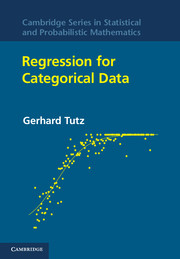Book contents
- Frontmatter
- Contents
- Preface
- 1 Introduction
- 2 Binary Regression: The Logit Model
- 3 Generalized Linear Models
- 4 Modeling of Binary Data
- 5 Alternative Binary Regression Models
- 6 Regularization and Variable Selection for Parametric Models
- 7 Regression Analysis of Count Data
- 8 Multinomial Response Models
- 9 Ordinal Response Models
- 10 Semi- and Non-Parametric Generalized Regression
- 11 Tree-Based Methods
- 12 The Analysis of Contingency Tables: Log-Linear and Graphical Models
- 13 Multivariate Response Models
- 14 Random Effects Models and Finite Mixtures
- 15 Prediction and Classification
- A Distributions
- B Some Basic Tools
- C Constrained Estimation
- D Kullback-Leibler Distance and Information-Based Criteria of Model Fit
- E Numerical Integration and Tools for Random Effects Modeling
- List of Examples
- Bibliography
- Author Index
- Subject Index
12 - The Analysis of Contingency Tables: Log-Linear and Graphical Models
Published online by Cambridge University Press: 05 June 2012
- Frontmatter
- Contents
- Preface
- 1 Introduction
- 2 Binary Regression: The Logit Model
- 3 Generalized Linear Models
- 4 Modeling of Binary Data
- 5 Alternative Binary Regression Models
- 6 Regularization and Variable Selection for Parametric Models
- 7 Regression Analysis of Count Data
- 8 Multinomial Response Models
- 9 Ordinal Response Models
- 10 Semi- and Non-Parametric Generalized Regression
- 11 Tree-Based Methods
- 12 The Analysis of Contingency Tables: Log-Linear and Graphical Models
- 13 Multivariate Response Models
- 14 Random Effects Models and Finite Mixtures
- 15 Prediction and Classification
- A Distributions
- B Some Basic Tools
- C Constrained Estimation
- D Kullback-Leibler Distance and Information-Based Criteria of Model Fit
- E Numerical Integration and Tools for Random Effects Modeling
- List of Examples
- Bibliography
- Author Index
- Subject Index
Summary
Contingency tables, or cross-classified data, come in various forms, differing in dimensions, distributional assumptions, and margins. In general, they may be seen as a structured way of representing count data. They were already used to represent data in binary and multinomial regression problems when explanatory variables were categorical (Chapters 2 and 8). Also, count data with categorical explanatory variables (Chapter 7) may be given in the form of contingency tables.
In this chapter log-linear models are presented that may be seen as regression models or association models, depending on the underlying distribution. Three types of distributions are considered: the Poisson distribution, the multinomial, and the product-multinomial distribution. When the underlying distribution is a Poisson distribution, one considers regression problems as in Chapter 7. When the underlying distribution is multinomial, or product-multinomial, one has more structure in the multinomial response than in the regression problems considered in Chapters 2 and 8. In those chapters the response is assumed to be multinomial without further structuring, whereas in the present chapter the multinomial response arises from the consideration of several response variables that together form a contingency table. Then one wants to analyze the association between these variables. Log-linear models provide a common tool to investigate the association structure in terms of independence or conditional independence between variables. Several examples of contingency tables have already been given in previous chapters. Two more examples are the following.
Information
- Type
- Chapter
- Information
- Regression for Categorical Data , pp. 331 - 362Publisher: Cambridge University PressPrint publication year: 2011
